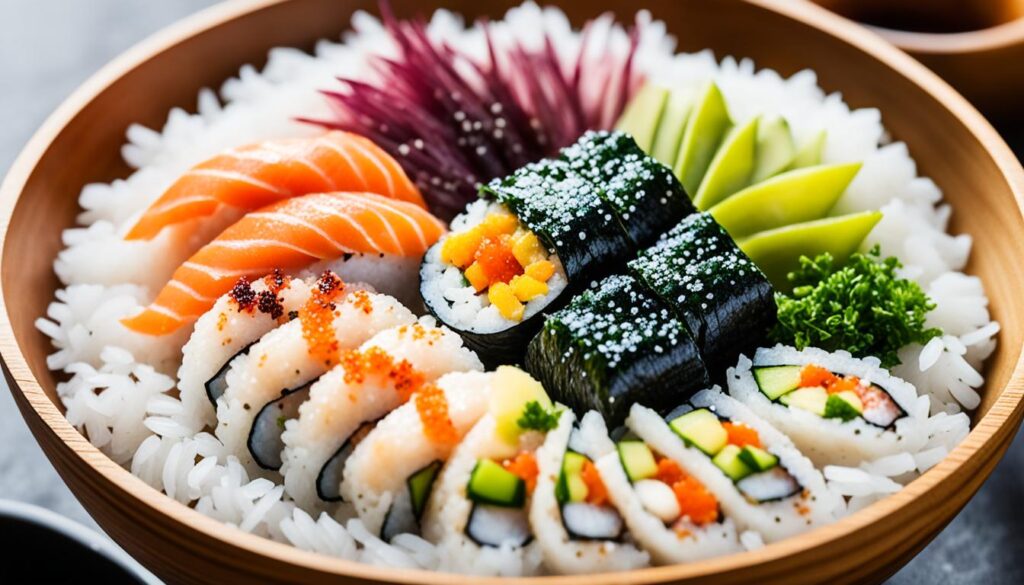Did you know that there are as many sushi vinegar recipes as there are sushi restaurants? That’s because the art of making sumeshi seasoned sushi rice is a true culinary masterpiece, with each chef putting their unique spin on the essential ingredients. In this article, we’ll share our authentic recipe and guide you through the process of creating the perfect, flavorful sushi rice at home.
The key to great sushi rice lies in the balance of its essential components: salt, sugar, and kombu (a type of dried kelp). These elements work together to create the perfect harmony of acidity, sweetness, and umami that is the hallmark of authentic Japanese sushi recipes. While sushi rice vinegar ratio and sushi rice preparation may vary, the foundational principles remain the same.
In our recipe, we’ll walk you through the step-by-step process of making the sushi rice seasoning and sushi rice cooking method to help you achieve homemade sushi rice perfection. By the time you’re done, you’ll have mastered the art of authentic sushi rice and be ready to create your own culinary masterpieces, with sushi rice calorie count in mind.
Mastering the Art of Sumeshi: Seasoned Sushi Rice Perfection
To create the perfect sushi rice, known as sumeshi, the selection of the right type of rice is crucial. We’ll want to opt for a Japanese short-grain variety, such as the renowned koshihikari, as its higher levels of glutinous amylopectin starch allow the grains to cling together beautifully. The small, plump shape of short-grain rice also enables it to absorb liquid more effectively than longer, fluffier varieties like jasmine or basmati.
The Importance of Selecting the Right Rice
The choice of sushi rice is paramount, as its texture and ability to hold together are essential for creating the perfect bite. Short-grain Japanese rice, with its unique starch profile, is the gold standard for achieving that characteristic sumeshi texture.
Understanding the Role of Kombu in Sushi Rice
Kombu, a dried kelp, adds a savory umami element to the sushi rice. The natural salinity and minerality it provides from the ocean helps to balance the flavors, creating a depth of taste that elevates the overall dish.
The Secrets of Sushi Vinegar: Balancing Flavors
The essential ingredients in sushi vinegar are salt, sugar, and kombu. These work in harmony to temper the sharpness of the vinegar, resulting in a seasoned rice that is both flavorful and perfectly balanced.
Sumeshi Seasoned Sushi Rice Recipe: Step-by-Step Guide
Preparing the Sushi Vinegar Solution
To create the perfect sumeshi seasoned sushi rice, we’ll start by preparing the sushi vinegar solution. In a stainless-steel bowl, we’ll whisk together rice vinegar, salt, and sugar. Then, we’ll pour the solution into a nonreactive, airtight container and add kombu, making sure it is fully submerged. We’ll allow the kombu to infuse at room temperature for 24 hours, allowing the natural salinity and minerality from the ocean to infuse the vinegar with its signature umami undertone.
Rinsing and Cooking the Sushi Rice
Next, we’ll turn our attention to the sushi rice itself. We’ll place the short-grain sushi rice in a large bowl and add enough cold water to cover. Gently massaging and swishing the grains in a circular motion, we’ll rinse the rice until the water turns cloudy, then drain it through a fine-mesh strainer. We’ll repeat this rinsing process until the water runs clear, ensuring we’ve removed any impurities. Finally, we’ll transfer the rinsed rice to the strainer and run it under cold water for 2-3 minutes, lightly agitating the rice to help filter out any small shards of broken grains. We’ll then allow the rice to drain and air dry in the strainer for 10 minutes.
Seasoning and Cooling the Sushi Rice
With the sushi rice cooked and rinsed, it’s time to season and cool it. We’ll transfer the hot, cooked rice to a wide, non-reactive container. Slowly, we’ll add the measured amount of sushi vinegar directly onto a rice paddle, waving the paddle back and forth to scatter and evenly distribute the vinegar onto the hot rice. Using long, sweeping strokes, we’ll smooth the rice into a flat, even layer, gently breaking up any clumps as we go. Once the rice is flat and all of the large clumps have been separated, we’ll push the rice into a pile on the side of the container to allow it to cool down, using a fan to help expedite the process.

Elevating Your Sumeshi Seasoned Sushi Rice Recipe
As you become more comfortable with preparing the sumeshi seasoned sushi rice, you may want to experiment with additional ingredients to take your recipe to new heights. While akazu vinegar, johakuto (a fine, slightly moist white sugar), or yakishio (roasted sea salt) can add unique flavor profiles, you don’t necessarily need the most premium products as long as you’ve got the fundamental sushi rice preparation and sushi rice seasoning techniques down.
Maintaining moist hands and tools is key to preventing the sushi rice from sticking to surfaces. The goal is to incorporate the flavorful sushi vinegar into the rice as evenly as possible without overworking or damaging the individual grains. The specific technique relies on a rice paddle or wooden spoon to deftly cut through and turn the rice, rather than mashing it into submission.
Your grip should be firm, but your strokes gentle and intentional, as you carefully break up any clumps while avoiding the already-mixed portions to prevent over-manipulation. This will result in Japanese sushi rice that is evenly seasoned, free of clumps or broken grains, and delightfully airy and light, rather than starchy, damp, and heavy. With practice, you’ll master the art of achieving authentic sushi rice that’s perfectly seasoned and ready for all your favorite homemade sushi creations.
